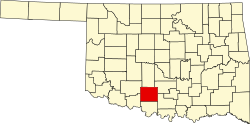Murders of Berch and Johnigan
On December 17, 1923, Albert W. Berch, a white hotel owner, and his Black porter, Robert Johnigan, were confronted and later murdered by an angry mob of Marlow residents at the Johnson Hotel. [a] [8] [9] Berch had hired Johnigan as a porter 10 days before Johnigan decided to quit, citing racial tensions and a planned move to Duncan, but upon the request of J. L. Campbell, [9] a guest from Norman, he decided to give one last shoe-shine. [8] A mob of at least 15 men approached the hotel after sundown, around 8:30 PM, [9] "who went to the hotel where the negro had been employed three days ago as a porter and shot down when Birch [b] attempted to persuade them to desist from their threat to lynch the negro." [10]
The mob entered the hotel via the lobby and continued into an adjoining room to find Johnigan shining Campbell's shoes, asking Johnigan to leave. [9] Campbell testified that one boy in the mob went into the room and grabbed Johnigan, but as Johnigan resisted, Campbell heard a gunshot, which prompted him to leave his chair just as Berch was falling. [9] Campbell testified that he was heading to the hotel's dining room and heard four shots in total but saw no weapon in Berch's hand or any person who fired a gun. [11] Berch had overheard the conflict between Johnigan and the mob, and he ordered the crowd to leave the hotel, stepping between Johnigan and mob member Marvin Kincannon, a man in his 20s alleged by Mrs. Berch as the leader of the mob. [12] [9]
Conflict escalated when Elza "Roy" Gandy apprehended Johnigan and began beating him with a stick. [8] According to hotel patron and eyewitness Walter O'Quinn, Berch struck Gandy, who landed back against a table. [9] When Berch ran to Johnigan's defense, Kincannon fired a fatal bullet into the chest of Berch, who died within minutes, before twice shooting Johnigan, who died from his injuries at around 5:30 AM the following day. [8] [13] [9] Other witnesses testified that it was Johnigan who knocked Gandy across a table and that Kincannon fired when the two were separated. [13] As Berch fell, Johnigan started toward the phone booth, but Kincannon shot him inside the phone booth. [9] Kincannon grabbed Johnigan out of the phone booth and shot him again in the chest. [9] Four shots in total were fired according to O'Quinn. [9]
Dr. Richards, a witness to the scene, testified that he saw Berch on the lobby floor succumbing to his wounds: "Birch [b] was dying, he only breathed a few more times after I got there and I saw I ocould do nothing for him and tried to do something for the nigger." [11] Richards claimed Johnigan lie wounded in front of the shine stand about 10 feet from Berch. [9] He claimed that "one of the bullets struck the negro just above the right breast nipple and lodged in the intestines, probably striking a rib and being deflected downward into the stomach.... The second bullet struck in the left groin and came out near the lower part of the hip, apparently being nothing more than a severe flesh wound." [9] According to a contemporary report by The Duncan Banner , "there had been trouble previous to the killing and that the negro had been warned by the defendants to leave the city." [9]
Kincannon, allegedly the only member of the mob to brandish firearms, left the scene in an automobile with his companions after the shooting and could not be located by police. [12] [9] After multiple related arrests, Kincannon surrendered himself to authorities in Duncan around 3:00 AM on December 22, 1923; he and the other suspects were arraigned that afternoon. [9] [14] A preliminary hearing on January 2, 1924, before County Judge Eugene Rice included Marvin Kincannon, Elza Gandy, Bryon Wright, Fred Stotts, Ollie Lloyd, Homer Thompson, Ellis Spence, and Frank Cain as defendants. [9] [14] Kincannon was the only individual formally charged with Albert Berch's killing. [9] On April 18, 1924, Kincannon appeared at district court for the murder charge of Berch, for which the state initially sought the death penalty according to County Attorney Paul Sullivan. [11] The Duncan Banner observed that the defendant decided not to refute that the shooter was Kincannon but instead plea self-defense. [11] Kincannon was convicted of first-degree manslaughter for Berch's death and sentenced to 25 years in state prison, of which he served 11. [8]
Gandy, whose father was a Marlow police officer, was also convicted of manslaughter for his role in inciting the mob, attacking Johnigan, and furnishing the firearm that was used in the killings. Gandy's sentence was declared as life imprisonment on May 15, 1926, but he received a 7-year sentence. [8] [15] An appellate court stated that "Gandy was one of the chief instigators of the mob which was formed to run the negro out of town." [15] Gandy denied that he instigated the mob or furnished Kincannon the gun. [15] Gandy received parole at least twice; once for seven days for his grandmother's death, reported on January 26, 1928, [16] and again for five days to visit his sick sister in Hobart, Oklahoma, on August 13, 1929. [17]
The story was featured in The Casper Daily Tribune , [10] The Albany-Decatur Daily , [18] the Shreveport Journal , [19] The Vancouver Daily Province , [20] and the Norfolk Ledger-Dispatch , [21] among others. Elza Gandy died on December 9, 1949, in Caldwell, Kansas. [22] Marvin Kincannon died at age 71 in July 1972. [23] In 2019, Berch's maternal grandson, Albert Berch Hollingsworth, published a non-fiction book about the incident titled Killing Albert Berch, which he spent five years researching. [8] [24]


